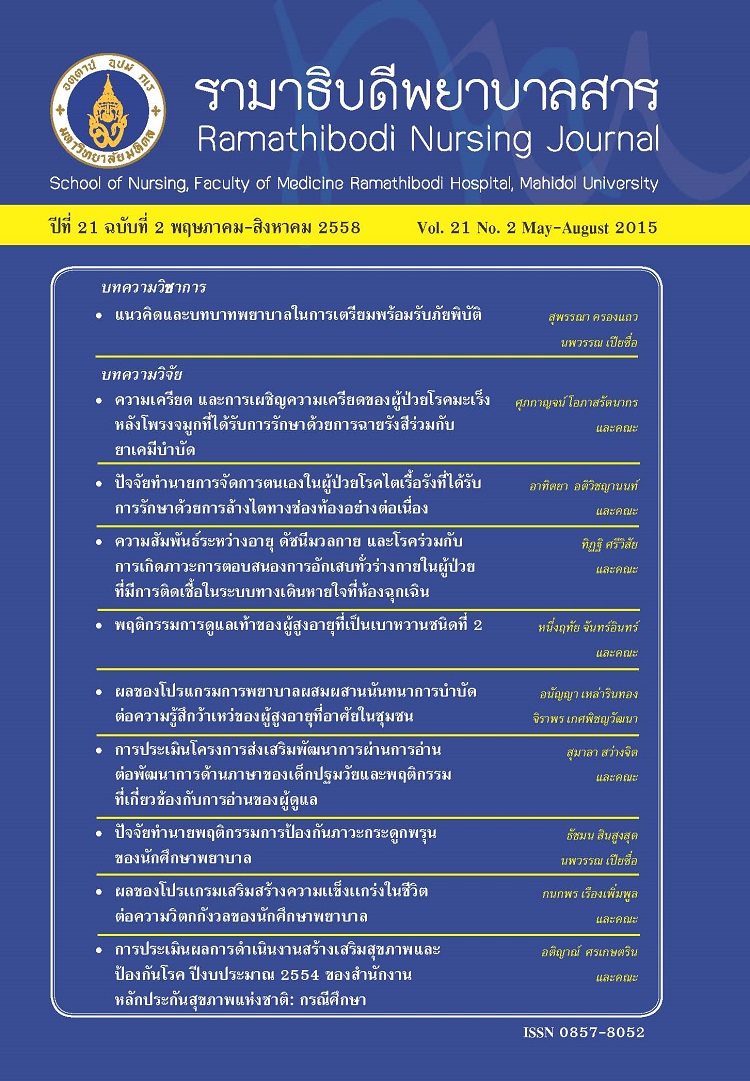Health Promotion and Disease Prevention of Health Security Office, Region 11 Suratthani: An Outcome Evaluation for the Budgetary Year of 2011
Main Article Content
Abstract
This research was aimed to study the budgetary implementation for health promotion and disease prevention in the regions and communities as well as to evaluate the outcomes of this implementation in the regions under the responsibility of Health Security Office, Region 11 Surat Thani. Both qualitative and quantitative methods were applied. Administrators or representatives from the authority of provincial health office were interviewed. Focus group discussion with representatives from contracting units for primary care (CUP) at districtlevel, from health promotion hospitals at sub-district level, and from local administration offices was conducted. One hundred and fifty nurses and health care personnel from health promotion hospitals were multi-stage randomly selected to answer the questionnaire. Data were analyzed by using content analysis, descriptive statistics such as percentage, mean, and standard deviation. What follows are results of the study. The budgetary implementation for health promotion and disease prevention of the provincial health offices is different from each other. For examples, some provincial offices emphasized working plans/projects that primarily solved the problems of their responsible areas. Some offices stressed on constructing integrative action plans, according to the government policy and national agenda in order to solve local problems. The budgetary implementation for health promotion and disease prevention of district health offices and community hospitals showed that the offices and hospitals (CUP) constructed the plans/projects, based on the problems and needs within their strategic plans as well as budget per capita that was allotted accordingly to the population under the responsibility of community health centers or health promotion hospitals. CUPs had integrated their budget with different parts that supported the policy of health promotion and disease prevention. The budgetary implementation for health promotion and disease prevention of health promotion hospitals at sub-district level and local administration offices showed that most implementation were integrated with other budgets. Plans/projects were constructed in the way that complied with the policy of the budget’s source or integrated projects were built by using problems and target population as a major factor. The outcome evaluation of health promotion and disease prevention revealed that in the project implementation, based on the indicators of health promotion and disease prevention, of previously budgetary year, each area provided different outcomes. In addition, the outcomes for some indicators had not been evaluated after implementation because the personnel did not understand how to collect data, there were not enough working personnel, and the personnel had other responsibilities.
Article Details
How to Cite
1.
Sarakshetrin A, watcharawiwat A, juntra rungnapa, kwanshom rostikorn, suwanpukde sumalee, pumput panida, ekkarat chuleeporn. Health Promotion and Disease Prevention of Health Security Office, Region 11 Suratthani: An Outcome Evaluation for the Budgetary Year of 2011. Nurs Res Inno J [internet]. 2015 Oct. 26 [cited 2025 Dec. 29];21(2):275-87. available from: https://he02.tci-thaijo.org/index.php/RNJ/article/view/18929
Section
บทความวิจัย
บทความ ข้อมูล เนื้อหา รูปภาพ ฯลฯ ที่ได้รับการตีพิมพ์ในรามาธิบดีพยาบาลสาร ถือเป็นลิขสิทธิ์ของวารสาร หากบุคคลหรือหน่วยงานใดต้องการนำทั้งหมดหรือส่วนหนึ่งส่วนใดไปเผยแพร่หรือเพื่อกระทำการใด ใด จะต้องได้รับอนุญาตเป็นลายลักษณ์อักษรจากรามาธิบดีพยาบาลสารก่อนเท่านั้น


